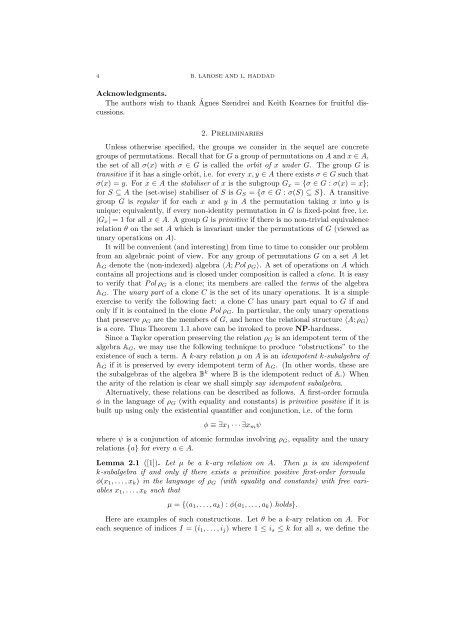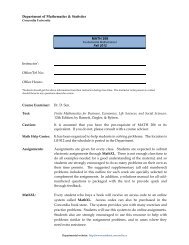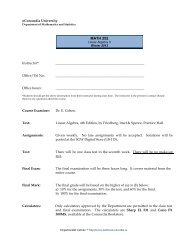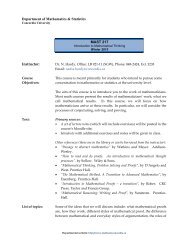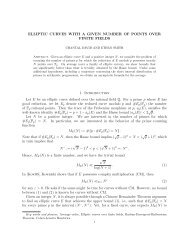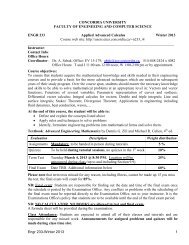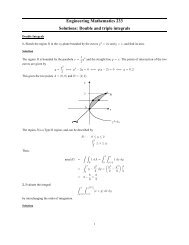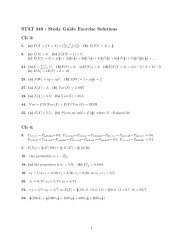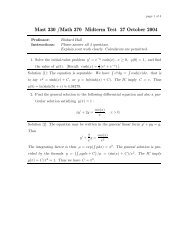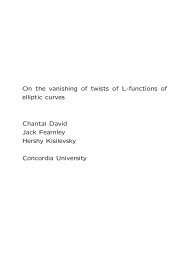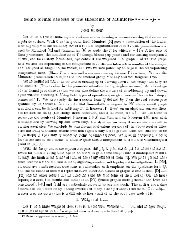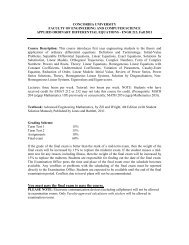COLOURINGS OF HYPERGRAPHS, PERMUTATION GROUPS ...
COLOURINGS OF HYPERGRAPHS, PERMUTATION GROUPS ...
COLOURINGS OF HYPERGRAPHS, PERMUTATION GROUPS ...
Create successful ePaper yourself
Turn your PDF publications into a flip-book with our unique Google optimized e-Paper software.
4 B. LAROSE AND L. HADDAD<br />
Acknowledgments.<br />
The authors wish to thank Ágnes Szendrei and Keith Kearnes for fruitful discussions.<br />
2. Preliminaries<br />
Unless otherwise specified, the groups we consider in the sequel are concrete<br />
groups of permutations. Recall that for G a group of permutations on A and x ∈ A,<br />
the set of all σ(x) with σ ∈ G is called the orbit of x under G. The group G is<br />
transitive if it has a single orbit, i.e. for every x, y ∈ A there exists σ ∈ G such that<br />
σ(x) = y. For x ∈ A the stabiliser of x is the subgroup G x = {σ ∈ G : σ(x) = x};<br />
for S ⊆ A the (set-wise) stabiliser of S is G S = {σ ∈ G : σ(S) ⊆ S}. A transitive<br />
group G is regular if for each x and y in A the permutation taking x into y is<br />
unique; equivalently, if every non-identity permutation in G is fixed-point free, i.e.<br />
|G x | = 1 for all x ∈ A. A group G is primitive if there is no non-trivial equivalence<br />
relation θ on the set A which is invariant under the permutations of G (viewed as<br />
unary operations on A).<br />
It will be convenient (and interesting) from time to time to consider our problem<br />
from an algebraic point of view. For any group of permutations G on a set A let<br />
A G denote the (non-indexed) algebra 〈A; P ol ρ G 〉. A set of operations on A which<br />
contains all projections and is closed under composition is called a clone. It is easy<br />
to verify that P ol ρ G is a clone; its members are called the terms of the algebra<br />
A G . The unary part of a clone C is the set of its unary operations. It is a simple<br />
exercise to verify the following fact: a clone C has unary part equal to G if and<br />
only if it is contained in the clone P ol ρ G . In particular, the only unary operations<br />
that preserve ρ G are the members of G, and hence the relational structure 〈A; ρ G 〉<br />
is a core. Thus Theorem 1.1 above can be invoked to prove NP-hardness.<br />
Since a Taylor operation preserving the relation ρ G is an idempotent term of the<br />
algebra A G , we may use the following technique to produce “obstructions” to the<br />
existence of such a term. A k-ary relation µ on A is an idempotent k-subalgebra of<br />
A G if it is preserved by every idempotent term of A G . (In other words, these are<br />
the subalgebras of the algebra B k where B is the idempotent reduct of A.) When<br />
the arity of the relation is clear we shall simply say idempotent subalgebra.<br />
Alternatively, these relations can be described as follows. A first-order formula<br />
φ in the language of ρ G (with equality and constants) is primitive positive if it is<br />
built up using only the existential quantifier and conjunction, i.e. of the form<br />
φ ≡ ∃x 1 · · · ∃x m ψ<br />
where ψ is a conjunction of atomic formulas involving ρ G , equality and the unary<br />
relations {a} for every a ∈ A.<br />
Lemma 2.1 ([1]). Let µ be a k-ary relation on A. Then µ is an idempotent<br />
k-subalgebra if and only if there exists a primitive positive first-order formula<br />
φ(x 1 , . . . , x k ) in the language of ρ G (with equality and constants) with free variables<br />
x 1 , . . . , x k such that<br />
µ = {(a 1 , . . . , a k ) : φ(a 1 , . . . , a k ) holds}.<br />
Here are examples of such constructions. Let θ be a k-ary relation on A. For<br />
each sequence of indices I = (i 1 , . . . , i j ) where 1 ≤ i s ≤ k for all s, we define the


